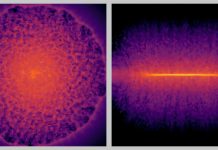
A big breakthrough from scientists at The University of Osaka could dramatically shrink the size of particle accelerators.
Traditionally, generating powerful proton beams with giga-electron-volt (GeV) energy levels required massive machines stretching for kilometers.
But now, researchers have shown it might be possible to do the same thing with a device small enough to fit in a laboratory.
Led by Professor Masakatsu Murakami, the team developed a new idea called micronozzle acceleration, or MNA for short.
The concept uses a specially designed microtarget—an incredibly small structure shaped like a nozzle.
This micro-nozzle contains a thin rod made of solid hydrogen, placed near the narrowest part of the nozzle.
When this target is hit with extremely intense, very short laser pulses, the nozzle acts like a powerful lens.
It focuses the laser energy directly onto the hydrogen rod, which helps create a strong electric field inside the nozzle.
This field then accelerates protons in a step-by-step process. In simulations, the method successfully pushed proton energies beyond 1 GeV—a first in the world using such a small device.
This is a major step forward. Traditional laser-based proton acceleration methods, which use flat surfaces instead of nozzle-shaped targets, have struggled to reach much beyond 100 mega-electron-volts (MeV).
With MNA, researchers can not only go well beyond that limit but also produce high-quality and stable proton beams, which are important for practical use.
According to Professor Murakami, this discovery could change the future of several industries. In medicine, compact and accurate proton beams could lead to more precise and affordable cancer treatments.
In energy, this technology could support laser fusion research, which aims to mimic the energy of stars. And in science, it could help researchers explore extreme environments similar to those found in space.
The research team tested their ideas through advanced computer simulations using the SQUID supercomputer in Osaka. Their results were published in Scientific Reports under the title “Generation of giga-electron-volt proton beams by micronozzle acceleration.”
In short, the combination of tiny nozzles and powerful lasers may make it possible to build tabletop accelerators that do what once required massive buildings—offering new tools for science, medicine, and clean energy.
Source: KSR.



